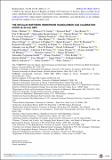The IntCal20 Northern Hemisphere radiocarbon age calibration curve (0-55 cal kBP)
Abstract
Radiocarbon (14C) ages cannot provide absolutely dated chronologies for archaeological or paleoenvironmental studies directly but must be converted to calendar age equivalents using a calibration curve compensating for fluctuations in atmospheric 14C concentration. Although calibration curves are constructed from independently dated archives, they invariably require revision as new data become available and our understanding of the Earth system improves. In this volume the international 14C calibration curves for both the Northern and Southern Hemispheres, as well as for the ocean surface layer, have been updated to include a wealth of new data and extended to 55,000 cal BP. Based on tree rings, IntCal20 now extends as a fully atmospheric record to ca. 13,900 cal BP. For the older part of the timescale, IntCal20 comprises statistically integrated evidence from floating tree-ring chronologies, lacustrine and marine sediments, speleothems, and corals. We utilized improved evaluation of the timescales and location variable 14C offsets from the atmosphere (reservoir age, dead carbon fraction) for each dataset. New statistical methods have refined the structure of the calibration curves while maintaining a robust treatment of uncertainties in the 14C ages, the calendar ages and other corrections. The inclusion of modeled marine reservoir ages derived from a three-dimensional ocean circulation model has allowed us to apply more appropriate reservoir corrections to the marine 14C data rather than the previous use of constant regional offsets from the atmosphere. Here we provide an overview of the new and revised datasets and the associated methods used for the construction of the IntCal20 curve and explore potential regional offsets for tree-ring data. We discuss the main differences with respect to the previous calibration curve, IntCal13, and some of the implications for archaeology and geosciences ranging from the recent past to the time of the extinction of the Neanderthals.
Citation
Reimer , P J , Austin , W , Bard , E , Bayliss , A , Blackwell , P G , Ramsey , C B , Butzin , M , Cheng , H , Edwards , R L , Friedrich , M , Grootes , P M , Guilderson , T P , Hajdas , I , Heaton , T J , Hogg , A G , Hughen , K A , Kromer , B , Manning , S W , Muscheler , R , Palmer , J G , Pearson , C , van der Plicht , J , Reimer , R W , Richards , D A , Scott , E M , Southon , J R , Turney , C S M , Wacker , L , Adolphi , F , Büntgen , U , Capano , M , Fahrni , S , Fogtmann-Schulz , A , Friedrich , R , Köhler , P , Kudsk , S , Miyake , F , Olsen , J , Reinig , F , Sakamoto , M , Sookdeo , A & Talamo , S 2020 , ' The IntCal20 Northern Hemisphere radiocarbon age calibration curve (0-55 cal kBP) ' , Radiocarbon , vol. 62 , no. 4 , pp. 725-757 . https://doi.org/10.1017/RDC.2020.41
Publication
Radiocarbon
Status
Peer reviewed
ISSN
0033-8222Type
Journal article
Description
Authors thank the National Natural Science Foundation of China grants NSFC 41888101 and NSFC 41731174, the 111 program of China (D19002), U.S. NSF Grant 1702816, and the Malcolm H. Wiener Foundation for support for research that contributed to the IntCal20 curve. The work on the Swiss and German YD trees was funded by the German Science foundation and the Swiss National Foundation (grant number: 200021L_157187). The operation in Aix-en-Provence is funded by the EQUIPEX ASTER-CEREGE, the Collège de France and the ANR project CARBOTRYDH (to EB). The work on the correlation of tree ring 14C with ice core 10Be was partially supported by the Swedish Research Council and the Knut and Alice Wallenberg foundation. M. Butzin is supported by the German Federal Ministry of Education and Research (BMBF) through the PalMod project (grant number: 01LP1505B). S. Talamo and M. Friedrich. are funded by the European Research Council under the European Union’s Horizon 2020 Research and Innovation Programme (grant agreement No. 803147-RESOLUTION, awarded to ST). C. Turney would like to acknowledge support of the Australian Research Council (FL100100195 and DP170104665). P. Reimer and W. Austin acknowledge the support of the UKRI Natural Environment Research Council (Grant NE/M004619/1).Collections
Items in the St Andrews Research Repository are protected by copyright, with all rights reserved, unless otherwise indicated.

